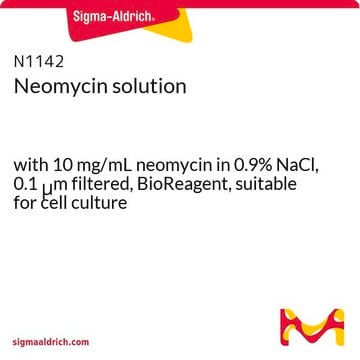540411
Puromycin, Dihydrochloride, Cell Culture-Tested
Puromycin, CAS 58-58-2, is a protein synthesis inhibitor that causes premature release of nascent polypeptide chains.
Sinónimos:
Puromycin, Dihydrochloride, Cell Culture-Tested
About This Item
Productos recomendados
Nivel de calidad
Ensayo
≥98% (HPLC)
Formulario
solid
fabricante / nombre comercial
Calbiochem®
condiciones de almacenamiento
OK to freeze
desiccated
impurezas
≤10 EU/mg Endotoxin (dry weight)
color
white to off-white
solubilidad
methanol: 20 mg/mL
water: 50 mg/mL
Condiciones de envío
ambient
temp. de almacenamiento
−20°C
InChI
1S/C22H29N7O5.2ClH/c1-28(2)19-17-20(25-10-24-19)29(11-26-17)22-18(31)16(15(9-30)34-22)27-21(32)14(23)8-12-4-6-13(33-3)7-5-12;;/h4-7,10-11,14-16,18,22,30-31H,8-9,23H2,1-3H3,(H,27,32);2*1H/t14-,15+,16?,18+,22+;;/m0../s1
Clave InChI
MKSVFGKWZLUTTO-USYAMCSGSA-N
Descripción general
Acciones bioquímicas o fisiológicas
protein synthesis
Advertencia
Reconstitución
Otras notas
Kaufman, S.H., et al. 1993. Cancer Res.53, 3976.
de la Luna, S. and Ortín, J. 1992. Methods Enzymol.216, 376.
Chow, S.C., et al. 1991. Exp. Cell Res. 216, 149.
Información legal
Palabra de señalización
Warning
Frases de peligro
Consejos de prudencia
Clasificaciones de peligro
Acute Tox. 4 Oral
Código de clase de almacenamiento
11 - Combustible Solids
Clase de riesgo para el agua (WGK)
WGK 3
Punto de inflamabilidad (°F)
Not applicable
Punto de inflamabilidad (°C)
Not applicable
Certificados de análisis (COA)
Busque Certificados de análisis (COA) introduciendo el número de lote del producto. Los números de lote se encuentran en la etiqueta del producto después de las palabras «Lot» o «Batch»
¿Ya tiene este producto?
Encuentre la documentación para los productos que ha comprado recientemente en la Biblioteca de documentos.
Los clientes también vieron
Active Filters
Nuestro equipo de científicos tiene experiencia en todas las áreas de investigación: Ciencias de la vida, Ciencia de los materiales, Síntesis química, Cromatografía, Analítica y muchas otras.
Póngase en contacto con el Servicio técnico













